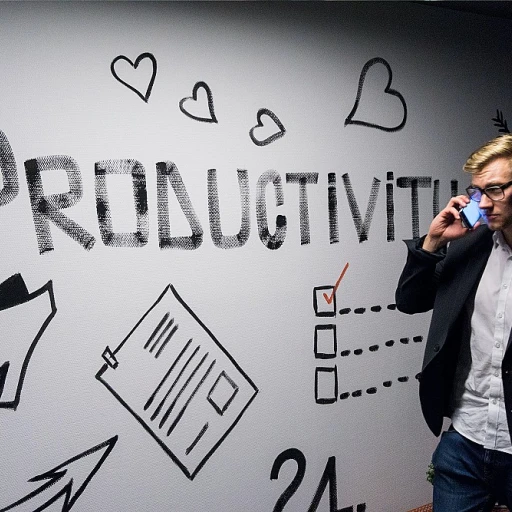Understanding the Role of HR in Modern Organizations
The Ever-Evolving Function of HR
Human resources has shifted beyond merely handling administrative duties. Today, it's a vital element in aligning employee performance with organizational goals. HR practices have developed to not only focus on efficiency and compliance but also the overall enrichment of the work environment. This has transformed HRM into a strategic pillar within any organization. Many successful businesses realize that their most valued assets are their employees. Staff development, wellbeing, and performance management become essential processes, establishing a connection between the workforce and business ambitions. These practices improve organizational performance and drive strategic human resource management. A strong HR department nurtures employee relationships, manages compensation benefits effectively, and fosters a responsive work environment. Modern HR experts bring a wealth of experience and knowledge, ensuring that their expertise earns the authority and trust of both staff and management alike.The Human Side of HR
Newer HRM practices tap into the human element more than ever before. The focus is now on employee engagement and talent management rather than outdated rigid oversight. This strategic shift helps organizations recognize the individual, understand their aspirations, and provide tailored training development programs to boost employee performance. Reflecting on personal stories from various HR managers, it's clear how significant HR’s role is. Imagine a manager noticing a decline in team morale. However, with targeted employee engagement practices, implementing a friendly open-door policy, and offering relevant growth opportunities, the situation vastly improved. This example underscores the potential impact HR initiatives can have on organizational dynamism and morale. If you're curious about specific strategies to improve organizational alignment and guide your HR efforts, check out this resource on boosting employee performance with effective HR management. It offers actionable insights that can definitely enhance your organization's HR function.Key HR Management Practices for Employee Engagement
Engaging Employees Through Proven Practices
In today's fast-paced business environment, keeping employees engaged is a top priority. Employee engagement is not just about keeping workers busy—it's about connecting them to the mission of your organization. When people feel like they belong and their efforts align with company goals, productivity and satisfaction soar. To boost employee engagement, consider applying a few proven practices:- Recognition and Rewards: Celebrate wins, big or small. Acknowledging achievements not only bolsters morale but also fosters an inspiring workplace.
- Open Communication: Encourage a culture where ideas flow freely. Transparent communication helps build trust and a shared vision.
- Career Development: Provide opportunities for professional growth through training and mentoring. Employees value career advancement as part of their journey.
Tech-Driven HR for Improved Organizational Performance
The role of technology in HR has expanded. Today's HR management practices increasingly rely on digital tools to enhance efficiency and performance. Tech-savvy HR departments can better track employee performance, streamline processes, and even predict future staffing needs.- Performance Management Software: This streamlines the evaluation process, providing real-time feedback and helping in setting achievable goals.
- Data Analytics: Leveraging data to identify trends and patterns in employee behavior and performance can guide decision making.
- HR Portals and Apps: These platforms offer employees a convenient way to access information, manage benefits, and engage with HR services directly.
Fostering a Learning Culture for Future Success
Organizations that prioritize continuous learning are ones that stay competitive. Investing in employee development isn’t just smart—it's essential. This commitment can transform your workplace into a vibrant center of knowledge and growth.- Encourage Learning Opportunities: Offer workshops, seminars, and courses. Whether it's a new skill or refining current ones, our people must be ready for the challenges ahead.
- Create a Mentorship Program: Pairing experienced staff with newcomers can spread knowledge and build strong, supportive bonds.
- Provide Access to Resources: Ensure employees have access to books, online courses, and other learning materials.
Leveraging Technology for HR Efficiency
Making the Most of Tech in HR
As today's business scene keeps shifting, smart use of technology in HR has turned into a big focus for organizations. It's not just about adopting new gadgets or software; it's about using tech to boost employee engagement and overall organizational performance. Streamlining Management Processes Tech can seriously transform how human resource management processes operate. With software solutions designed to handle employee data, attendance, and performance management, HR teams can free up time previously spent on administrative work. This doesn't just lighten the load for HR professionals but also speeds up the workflow within the organization, ensuring everyone has access to timely and accurate information. Boosting Employee Engagement When it comes to keeping employees motivated, technology can play a pivotal role. Platforms offering personalized learning and development opportunities can make staff development a part of every workday. Employees can gain new skills and expand their knowledge, aligning with both their personal goals and the organization’s strategic human objectives. Improving Performance Management Performance management practices have been revolutionized thanks to new tech innovations. Digital performance tracking tools offer real-time feedback, creating an environment where continuous improvement becomes the norm. This kind of visibility in performance management can enhance compensation benefits strategies, ensuring that rewards are tied to measurable achievements. Efficient Training and Development Although traditional training model methods have their benefits, digital solutions have introduced a more efficient and widespread approach to training and development. Virtual classrooms and e-learning platforms provide access to a breadth of resources that support varied learning styles all in one place. Empowering HR Managers through Effective Training can enhance employee relations as the workforce feels more supported in their growth. By weaving technology into HRM, organizations not only refine their HR practices but also position themselves to meet and exceed their organizational goals.Developing a Culture of Continuous Learning
The Power of Continuous Learning in HR Management
Building a culture that values ongoing learning is essential for any organization striving to enhance employee performance and engagement. Nurturing an environment where employees feel encouraged to learn and grow can pave the way for a more motivated and skilled workforce. Employees who are given opportunities to improve their skills tend to be more engaged and satisfied with their work. Incorporating continuous learning practices into your organization's human resource management is a win-win situation, benefiting both the individual and the organization. To begin, it's crucial to offer diverse training and development opportunities. Consider providing access to workshops, seminars, and online courses that align with your business goals. This approach can help broaden the knowledge base and skills of your employees, making them more effective in their roles. Next, ensure that there is a clear process for career development and growth within the organization. Employees should have a clear understanding of the paths available for advancement and the resources necessary to achieve these goals. This transparency not only boosts morale but also fosters a sense of loyalty and commitment to the organization. Performance management systems should also emphasize continuous learning by setting and tracking learning objectives alongside performance goals. Employees who see the direct impact of their learning on their performance are more likely to stay motivated and committed to their development. Best Practices for Promoting Continuous Learning- Regular Feedback: Provide regular, constructive feedback to employees. This helps them understand areas of improvement and motivates them to pursue learning opportunities.
- Mentorship Programs: Pairing less experienced employees with seasoned mentors can facilitate knowledge sharing and professional development.
- Accessible Learning Platforms: Invest in user-friendly online platforms that offer a variety of learning materials accessible to all employees.
- Encourage Peer-to-Peer Learning: Create opportunities for employees to share their expertise through presentations, workshops, or informal knowledge-sharing sessions.
Balancing Compliance and Employee Well-being
Finding the Balance Between Compliance and Well-being
In the dance of human resources, finding harmony between compliance and employee well-being is like walking a tightrope. Organizations need to ensure they meet all legal requirements while also nurturing a positive work environment. It’s a balancing act that requires skill and finesse, but when done right, it can lead to improved organizational performance.
Compliance is non-negotiable. It involves adhering to labor laws, regulations, and internal policies. Yet, focusing solely on compliance can make the workplace feel rigid and uninviting. On the flip side, prioritizing well-being without regard to compliance can lead to legal troubles. The secret is to integrate both seamlessly into your HRM practices.
Strategies for Balancing Compliance and Well-being
- Regular Training and Development: Conduct training sessions to keep your HR team updated on the latest regulations and best practices. This not only ensures compliance but also empowers employees with knowledge and skills.
- Open Communication Channels: Encourage employees to voice their concerns and suggestions. This fosters a culture of trust and transparency, which can help in identifying potential compliance issues early on.
- Flexible Work Environment: Implement flexible work policies that consider employee needs while staying within legal boundaries. Flexibility can boost employee engagement and satisfaction.
- Comprehensive Employee Benefits: Offer benefits that cater to both legal requirements and employee well-being. This could include health insurance, mental health support, and wellness programs.
By focusing on these practices, organizations can create a work environment where employees feel valued and protected. It's about blending compliance with compassion to achieve both organizational goals and employee satisfaction.
Remember, the goal is not just to tick boxes but to create a workplace where employees thrive. This balance can lead to better employee performance and, ultimately, a more successful business.
Measuring the Impact of HR Initiatives
Evaluating the Effectiveness of HR Practices
Understanding the effectiveness of HR practices is vital for improving organizational performance. It’s important for HR professionals to measure how their initiatives impact both employees and the organization as a whole. Let’s look at some tried and tested methods for evaluating HR efforts.- Feedback Mechanisms: Regular feedback from employees can provide valuable insights into the effectiveness of HR practices. Surveys, focus groups, and suggestion boxes are traditional yet powerful tools to gather employee opinions. When employees feel heard, their engagement and relationship with the company grow stronger.
- Performance Metrics: Just like any business process, HR practices should be measured against certain benchmarks. Metrics such as employee turnover rates, average performance review scores, and the effectiveness of training development can indicate how well HR strategies are working. Organizations can use these metrics to continuously refine their human resources approach.
- Cost-Benefit Analysis: Understanding the financial implications of HR practices is also crucial. This involves looking at the costs involved in HR initiatives, such as management compensation and training costs, compared to the benefits like improved employee performance, increased organizational productivity, and enhanced employee engagement.
- Technology Utilization: Leveraging data analytics through HR management software systems helps track the success of HR initiatives in real-time. These tools can analyze patterns in employee performance and development, giving HR managers the ability to make informed decisions about what works best.
- Strategic Alignment: The success of HR initiatives should be evaluated in terms of how well they align with the organization’s strategic goals. When HR efforts are in sync with organizational objectives, they are more likely to improve overall performance and employee satisfaction.








